Grateful American™ Kids Introduce Us to Revolutionary Era Painter Charles Willson Peale
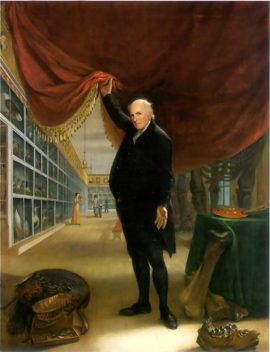 Revolutionary Era artist Charles Willson Peale’s long life spanned a period of dramatic changes in America, and in American art. The artist was born near Annapolis, MD, on April 15, 1741, and died 85 years later in Philadelphia on Feb 22, 1827. His work, some of which hangs in the Virginia Museum of Fine Arts (VMFA) in Richmond, depicts people and places that existed when the Colonies were new.
Revolutionary Era artist Charles Willson Peale’s long life spanned a period of dramatic changes in America, and in American art. The artist was born near Annapolis, MD, on April 15, 1741, and died 85 years later in Philadelphia on Feb 22, 1827. His work, some of which hangs in the Virginia Museum of Fine Arts (VMFA) in Richmond, depicts people and places that existed when the Colonies were new.
To restore enthusiasm in American history for kids and adults, Grateful American™ Foundation founder David Bruce Smith and Executive Producer Hope Katz Gibbs created a new website just for kids called Grateful American™ Kids, and this month the website features a video about the celebrated artist. The video is part of our new history TV show for kids, by kids. (Click on the video above, and take the short quiz at the end of this article.)
The actors in the video bring Peale to life as well as a young child whom Peale portrayed in a painting of the child’s grandfather, and a few of Peale’s 17 children. In the video, the reenactors hold fascinating conversations geared for young viewers that convey what life in America was like in its formative period.
What can Grateful American™ Kids teach us about this extraordinary man? Scroll down for a transcription of the script performed by 4th grade students from the Richmond, VA, school — Sabot at Stony Point. And be sure to watch our video (at GratefulAmericanTV.com), where you’ll meet Richmond actor Chris Dunn, who portrays Peale.
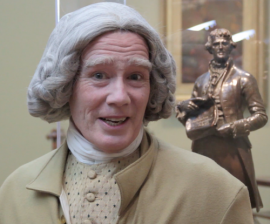 Charles Willson Peale: Hello, I’m American Revolutionary Era artist Charles Willson Peale and I am thrilled to welcome all of you Grateful American™ Kids to this segment of our new history TV show for kids, by kids.
Charles Willson Peale: Hello, I’m American Revolutionary Era artist Charles Willson Peale and I am thrilled to welcome all of you Grateful American™ Kids to this segment of our new history TV show for kids, by kids.
I was born near Annapolis, MD, on April 15, 1741 and died in Philadelphia, Pennsylvania on Feb. 22, 1827. In the 85 years of my life, much changed in America — and in the world of American art.
We are here at the Virginia Museum of Fine Arts in Richmond, VA, so that I can introduce you to some of the art that was created when our country was just starting out.
In addition to painting the portraits of famous Americans like George Washington and Benjamin Franklin, what I love about this museum is that it reminds me of the one I founded in Philadelphia. Granted that first one failed, but then my next try was a hit, but we’ll get to all of that soon enough.
In fact, today you will meet some of the people in my family and life and learn about what it was like to be an artist during this period in American history — including the young boy in this painting, which I created when he was 2.
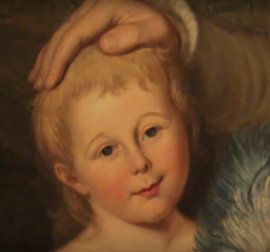 Now, I’d like to welcome Robert Smith, the young boy in this painting I did of him and his grandfather, which now hangs in the Virginia Museum of Fine Arts. (You can see this painting here, on the VMFA’s website.)
Now, I’d like to welcome Robert Smith, the young boy in this painting I did of him and his grandfather, which now hangs in the Virginia Museum of Fine Arts. (You can see this painting here, on the VMFA’s website.)
Robert, I’m very happy to be talking to you about this painting that I did of you and your grandfather William Smith in 1788. Did you know that it took me three weeks to complete? It was your father, General Otho Holland Williams, who commissioned me to do this piece, because your grandfather was a well-known merchant and statesman. In fact, he was one of the first members of the United States Congress, and it was he who insisted that you be in the painting!
Robert Smith: Was your father a painter, too?
Charles Willson Peale: Oh, no. My father, Charles Peale, was a postal clerk in London, England. He stole some money, and instead of going to prison, he was sent America, where he became a headmaster at a school in Maryland. Unfortunately, he died when I was only 8.
Robert Smith: Then what inspired you to become a painter?
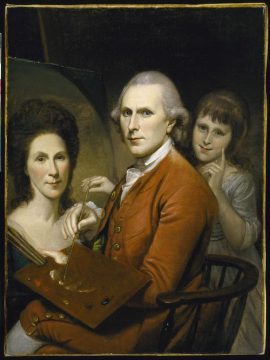 Charles Willson Peale: Well, when I was 13, I apprenticed for a saddle-maker in Annapolis, MD, and by the time I was 21 I had my own shop. I also repaired clocks and watches but I didn’t make a lot of money. I did, however, get to meet some very rich, well-educated people, and in 1762 something amazing happened. I was invited to the home of Philadelphia painter and engraver James Claypoole, Jr. When I saw the artwork in his home, that excited me about art, and I think that’s where my life as an artist truly began.
Charles Willson Peale: Well, when I was 13, I apprenticed for a saddle-maker in Annapolis, MD, and by the time I was 21 I had my own shop. I also repaired clocks and watches but I didn’t make a lot of money. I did, however, get to meet some very rich, well-educated people, and in 1762 something amazing happened. I was invited to the home of Philadelphia painter and engraver James Claypoole, Jr. When I saw the artwork in his home, that excited me about art, and I think that’s where my life as an artist truly began.
Robert Smith: Once you became a painter, what kind of things did you paint?
Charles Willson Peale: Over the course of my career I did 771 oil portraits, 297 miniatures, 29 landscapes, 11 still-lifes, and 10 history paintings … but who’s counting?
Robert Smith: I heard that you were married three times and had 17 kids, and that many of them became artists, too!
Charles Willson Peale: I’m glad you asked me about that because one of my sons, Rembrandt, is here right now. Rembrandt became a famous still-life painter as well.
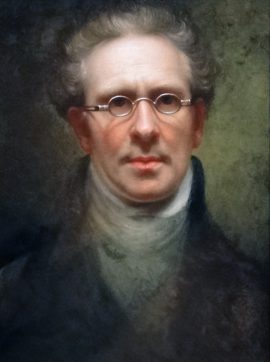 Rembrandt Peale: Hello, Robert. Father, there is so much wonderful symbolism in the painting Robert is in.
Rembrandt Peale: Hello, Robert. Father, there is so much wonderful symbolism in the painting Robert is in.
Charles Willson Peale: Yes, there is! Let’s start with the country estate in the background. That represents the wealth that Mr. Smith accumulated during his years as a merchant. And notice the peach, the pruning knife, and the book. They represent his avid interest in horticulture. Those columns that I added in the background represent the stability of the new country, and they also bring to mind the republican values of ancient Rome. You can see why this painting is an example of “Narrative Portraiture” — it tells a story!
Robert Smith: So does the painting hanging right next to the one of my grandfather and me at the VMFA. It’s a portrait of a prominent lady named Elizabeth Page, who later married Mr. Benjamin Harrison, who was related to the ninth president of the United States, William Henry Harrison. (You can also see this painting on VMFA’s website.)
Charles Willson Peale: Remember when I told you I painted presidents and some of the Founding Fathers? I also painted prominent people like Mrs. Benjamin Harrison. She was a member of Virginia’s “landed gentry” because she was part of a social group that owned land. She grew up on a beautiful farm called Roswell Plantation that was built by her father in Gloucester County, VA. When I painted her in 1775, I added roses to her dress. Gan you guess why I included an unopened rosebud? To show that she’s probably expecting a child.
Rembrandt Peale: Does Robert know how you learned to be such a great painter?
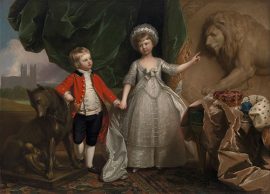 Charles Willson Peale: Well let me tell you about one of the paintings done by my teacher, Benjamin West, that’s also in the VMFA. Benjamin West was a painter to the kings and queens of England. King George III commissioned Mr. West to do a painting of his niece and nephew in 1779 during the American Revolution. The painting was meant to remind people that they should be loyal to the king. The Virginia Museum of Fine Arts has one of your paintings, Rembrandt, of a famous lawyer. It shows John Marshall, the fourth chief justice of the United States.
Charles Willson Peale: Well let me tell you about one of the paintings done by my teacher, Benjamin West, that’s also in the VMFA. Benjamin West was a painter to the kings and queens of England. King George III commissioned Mr. West to do a painting of his niece and nephew in 1779 during the American Revolution. The painting was meant to remind people that they should be loyal to the king. The Virginia Museum of Fine Arts has one of your paintings, Rembrandt, of a famous lawyer. It shows John Marshall, the fourth chief justice of the United States.
Rembrandt Peale: Father, I’m very proud of that painting. My goal was to capture Justice Marshall’s inner character and judicial temperament.
 Charles Willson Peale: Well, you did a magnificent job. But remember, you aren’t the only talented member of our family. I had 11 children with your mother, Rachel, whom I married in 1762, and I named several of our children after artists.
Charles Willson Peale: Well, you did a magnificent job. But remember, you aren’t the only talented member of our family. I had 11 children with your mother, Rachel, whom I married in 1762, and I named several of our children after artists.
There was Raphaelle, the still-life painter, Rubens managed our museum in Philadelphia, and Titian took part in expeditions out West. And of course there was my brother James, your uncle. He became a famous painter and he had many children — including three daughters who became some of the first female American painters: Margaretta Angelica Peale, Anna Claypoole Peale, and Sarah Miriam Peale.
Anna Claypoole and Sarah Miriam, it’s wonderful to have you with us today. Both of you grew up to be such well-known artists. Sarah Miriam, some of your still-lifes are at the VMFA, and you became such a fine portrait artist, too.
Sarah Miriam: I was the youngest in my family — born in 1800 in Philadelphia. When I was 16 I decided to show my art, my still-life paintings, in public and found my passion, which is portraiture.
Charles Willson Peale: Anna Claypoole and Sarah Miriam, we’re so proud that you were the first two women accepted into the Pennsylvania Academy of Fine Arts.
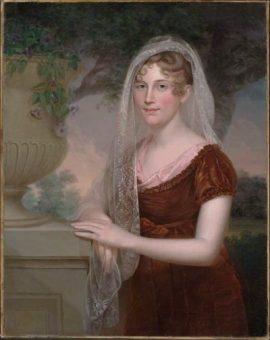 Anna Claypoole: Sarah Miriam, you were especially prolific. You painted more than 100 commissioned portraits, including some of the wealthiest residents in Baltimore and politicians from Washington, DC. I always loved your still-life work; I think my favorite is “Basket of Berries,” which you painted in 1860.
Anna Claypoole: Sarah Miriam, you were especially prolific. You painted more than 100 commissioned portraits, including some of the wealthiest residents in Baltimore and politicians from Washington, DC. I always loved your still-life work; I think my favorite is “Basket of Berries,” which you painted in 1860.
Charles Willson Peale: Anna, we’re proud of you, too. You captured the essence of the people who sat for you, and in fact at the age of 20 you were part of our first exhibit at the Pennsylvania Academy of Fine Arts, which for you became a major exhibit.
Anna Claypoole: Oh, that was a divine experience, wasn’t it, Sarah Miriam? But I think the moment that truly took our breath away was in 1824 when we became the first women elected academics in the Academy.
Sarah Miriam: It was such an honor, for us and the entire family.
 Charles Willson Peale: I’m proud of my role in helping to found the Pennsylvania Academy of Fine Arts in 1805 with my good friend and sculptor William Rush. In 1811, I also organized annual art exhibitions. President Thomas Jefferson, who was in his second term at the time, was a great supporter not only of my work, but of this museum. The museum’s goal is to collect works by leading American artists and distinguished alumni of the school.
Charles Willson Peale: I’m proud of my role in helping to found the Pennsylvania Academy of Fine Arts in 1805 with my good friend and sculptor William Rush. In 1811, I also organized annual art exhibitions. President Thomas Jefferson, who was in his second term at the time, was a great supporter not only of my work, but of this museum. The museum’s goal is to collect works by leading American artists and distinguished alumni of the school.
Benjamin Franklin was also a great supporter of my work and this museum. He wrote me a letter from London in 1771, when I was just 30, in which he said, “The Arts have always traveled Westward, and there is no doubt of their flourishing hereafter on our side of the Atlantic, as the number of wealthy inhabitants shall increase, who may be able and willing suitably to reward them.”
Is it too immodest to tell you that I was called a Renaissance Man? Not only did I have expertise in painting, but also carpentry, dentistry, optometry, shoe making, and taxidermy. I also wrote several books, including an essay on building wooden bridges and an epistle to a friend on the means of preserving health, but perhaps my family is my greatest legacy. My three wives and 17 children have given me great pleasure.
I bid you farewell and I hope our conversation on Grateful American™ Kids TV inspires you to learn more about history and perhaps pick up a paintbrush and see what you can create!
Take This Fun, Five-Question Quiz
Look for hints in the video that give clues to the answers!
1. What does “VMFA” stand for?
A) Vermont Military and Farming Association
B) Vegetarian Moms for Agriculture
C) Virginia Museum of Fine Arts
D) Victorian Models and Fashion Affiliation
The answer is C) the Virginia Museum of Fine Arts.
2. How many children did Charles Willson Peale have?
A) 10
B) 17
C) 2
D) 24
The answer is B) 17.
3. Who was Charles Willson Peale’s art teacher?
A) Benjamin West
B) Kanye West
C) Cornel West
D) Adam West
The answer of course is A) Benjamin West, who was one of the most famous painters of the time in London.
4. Which academy did artists Anna Claypoole and Sarah Miriam get accepted to?
A) Hogwarts School of Wizardry and Witchcraft
B) Starfleet Academy
C) Xavier’s School for Gifted Youngsters
D) Pennsylvania Academy of Fine Arts
The answer is D) the Pennsylvania Academy of Fine Arts.
5. Charles Willson Peale helped discover and put together the remnant of which ancient animal?
A) Saber-Toothed Tiger
B) Mastodon Elephant
C) Tyrannosaurus Rex
D) Megalodon Shark
The answer is B) a Mastodon Elephant.
Thank you so much for taking the quiz about Revolutionary War painter Charles Willson Peale.
Here’s to getting excited about studying American history!



